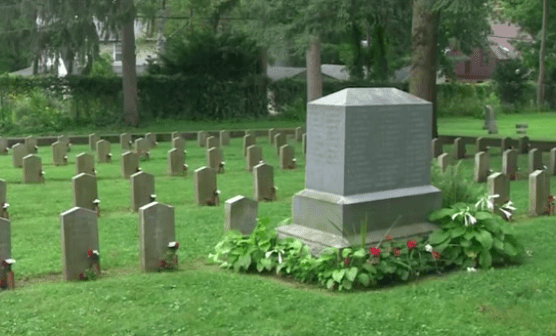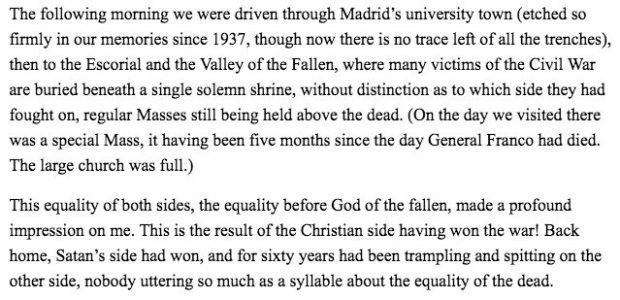Prelude To A New Civil War?

Matthew Schmitz posted this comment from Solzhenitsyn to Twitter just now:

Well. In Madison, Wisconsin, the city council has voted overwhelmingly to remove a cemetery marker noting the names of about 140 Confederates, most of whom died in a prisoner of war camp in the town. More:
“You don’t have discussion in a cemetery. You have reflection, and you have memories, and this (monument) brings up memories that are not so pleasant in our history,” said Council Vice President Sheri Carter.
These are Americans who died as prisoners of war. “They die off like rotten sheep,” said a Union soldier who worked at the camp, where conditions were bad. The “monument” is a tombstone large enough to feature the names of each of the dead. This is not a statue of a Confederate war hero. It is simply a grave marker noting the names of POWs who died far from home.
There is no longer equality before God of the fallen, not in Madison, Wisconsin. The city council spits on these dead men, who passed away not in combat, but in Union custody.
In Grace Church cemetery in my Louisiana hometown, you can visit the grave of Lt. Commander John Hart, US Navy, who captained a Union gunboat that was shelling the town and that very church in 1863 [a local friend just informed me that Hart’s boat was blockading the town to prevent contraband from coming and going; the Union gunboat that shelled the town came in 1864]. Cmdr Hart committed suicide on the boat during the battle. He was a Freemason, as many of the Confederates were. Hart’s men asked for a truce, and for the right to bury their commander in the Grace Church cemetery with full Masonic honors. The Confederate Masons agreed. So the war stopped while all the combatants gathered around the grave to commit Cmdr Hart to the earth.
Children in my hometown are often taken to Hart’s grave and told the story. His grave is treated with great respect locally, and always has been. That’s what decent people do for the dead. There is a brotherhood that defies mortal conflicts.
The leaders of Madison, Wisconsin, are manifestly not decent people. God preserve us Southerners from behaving so shamefully. I suppose it won’t be long before they disinter the Confederate bodies and put them on a barge down the Mississippi.
It’s hard to imagine what kind of despicable people destroy a tombstone — a tombstone! — for political reasons. This is a sign of the times — and of a time to come.
UPDATE: Here’s the text from a 1990s-era story from the Baton Rouge Advocate, written by George Morris, telling about the local woman who rescued that cemetery from ruin. Notice that the people of Madison did their best to take care of the interned POWs, and that when Mrs. Waterman died, one of her pallbearers was a former Wisconsin governor and wounded Union veteran. This is the noble history of Union supporters and veterans that the current Madison City Council defecates on:
Alice Whiting Waterman, born in Baton Rouge in 1820, is buried in the Confederate Rest section of Madison’s Forest Hill Cemetery. That is a rare honor for any non-soldier, much less a woman. But Waterman earned the right by pouring the last 30 years of her life into caring for the fallen warriors interred there.
That the cemetery exists at all is a matter of historical accident. In the spring of 1862, Southern soldiers were defending Island No. 10 in the Mississippi River a few miles south of New Madrid, Mo. They had been stationed there to prevent Union warships ,reinforcements and supplies from getting to Gen. Ulysses Grant, who was fighting farther to the south in Tennessee. When Union troops captured New Madrid on March 14, the soldiers on Island No. 10 found themselves surrounded. The Mississippi River was high, forcing many of the defenders to fight in knee- and waist-deep water. Badly outnumbered, they finally surrendered on April 8, 1862. More than 1,000 were captured and shipped north.
Under normal circumstances, they would have gone to Camp Douglas in Chicago or the Rock Island, Ill., prison camp. The Battle of Shiloh, however, had ended a day before their surrender, and the Union suddenly had more Confederate prisoners than it knew what to do with. So, many were taken to Camp Randall, a Union training base in Madison. From their ordeal on the island and the cold train ride north, pneumonia and other diseases ravaged the Confederates.
“Word spread like wildfire through the city of Madison that they were going to get these Confederate soldiers, so everybody got to the railroad station,” said Jim Zeirke of Sussex, Wis. Zeirke is historian for the Alice Whiting Waterman Camp of the Sons of Confederate Veterans. The long stream of sick and wounded soldiers touched the crowd, Zeirke said. “Some woman just cried out in the crowd, ‘My God, that could be my son,’ ” Zeirke said. “Something about that electrified the community, and the next thing you know they’re bringing milk, cheese, meat, all sorts of food products, all sorts of medicines, blankets, clothing, everything for these prisoners. The Wisconsin Union soldiers training at Camp Randall are starting to get kind of irritated because they’ve never had this kind of attention.”
For many, the kindness was too little too late. By the end of May, 114 prisoners died. Before the prisoners were moved to Camp Douglas in July, the death toll reached 140. The town quickly forgot those left behind. Waterman discovered this when she came to Madison in 1868. The cemetery was badly overgrown and the wooden headboards rotting.
“Nobody in the North thought they should take care of it. It was their enemies, and why take care of it?” said Jim Heberling of Madison, who has researched the cemetery’s history. “Then she saw it. She felt it was part of her heritage, and she took care of it.”
A childless widow who worked in rooming houses to make a living, Waterman’s sacrifice was considerable. She bought new wood headboards. She weeded the cemetery and planted trees, hedges and flowers. Accounts differ as to whether she accepted any financial help for the work, but most agree that the bulk of it came from her pocketbook.
“I’ve seen some indication in some other history of her that she was a very modest woman, judged by the fact that we don’t have a lot of terrific background on her,” Zeirke said. “I’m not aware that she was ever profiled. I’ve looked through some old newspapers. I’ve never done an extensive search. I wish they had Nexis and Lexis for the 1880s.”
“She said about the men buried there, ‘They are mine. I belong to them and they to me. They are my boys,’ ” Heberling said.
When Waterman died on Sept. 13, 1897, her work had become famous in Madison. Former Wisconsin Gov. Lucius Fairchild, a Union veteran who had been wounded in the war, was one of her pallbearers in a funeral attended by many prominent residents. An obituary in the Wisconsin State Journal lauded her life’s work, which others would continue. Permanent headstones have replaced the wooden ones, and a brass plaque now explains the history and Waterman’s contributions. Part of Forest Hill Cemetery, this section is called Confederate Rest. Zeirke and Heberling believe it is the nation’s northernmost Confederate cemetery.
“Mrs. Waterman, being of Southern birth, took a very tender and touching interest in the plot occupied by 100 or more Confederate dead,” her obituary said. “She beautified the spot, encircled it with shade trees … and for these soldiers lying so far among strangers she unceasingly performed the most sweet and charitable labor of love. At her own request and on the exact spot long since designated by her, she will be laid to rest with her ‘boys,’ as she so fondly called them.”
Subscribe for as little as $5/mo to start commenting on Rod’s blog.